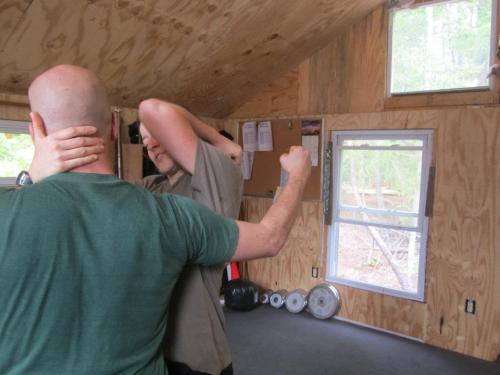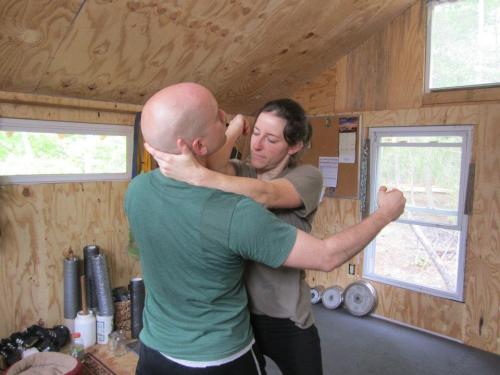One of our VA students exploring the utility of the elbows at close range to strike upwards and/or cover, then strike downwards into the throat or clavicles on the return. The collar tie can come out of the strike or cover, or from the other arm, and gives her the ability to create a force couple between elbow and target.
FSRI Contributors:
- Gillian Russell
- David Chopper Campbell
- kevinpreilly
- Randy Simpson, M.S.
- Robert Miller CPT CES PES
-
Recent Posts
Anatomy Resources
Blogroll
DIY Training Equipment
FSRI Clubs
FSRI Original Research
- More on Perception: Don't Just Rely on Visual Input
- Evidence Based Practice in the Fighting Arts: Appraisal and Suggestions
- Change Blindness and it's Relationship to Training
- More on Rhabdomyolysis and the Fighting Arts
- Applying Sports Science to the Fighting Arts
- Understanding Karate by De-emphasizing Kata
- Bernard Bettelheim: The Misadventures of a Missionary in 18th Century Okinawa
- Epistemic Viciousness in the Martial Arts
FSRI Training/Teaching Resources
- Using the Overhead Squat Assessment to Identify Reductions in Punching Quality
- Stretches for Striking
- Health, Injuries, Limitations, and Challenges
- Stretches for Striking
- Leg Conditioning and the IT Band
- Getting More out of your Heavy Bag
- Basic Physical Training Concepts for Fighting Arts Practitioners
- Knee Osteoarthritis in the Fighting Arts and Combat Sports
- Vertebral Artery and Carotid Artery Dissection Resulting From Mild Neck Trauma
- Basic Physical Training Resources for Fighting Arts Practitioners, pt. 2
Mugs and T-shirts
Recommended Fighting Arts
Recommended Trainers
Research Resources
- Journal of Sports Science and Medicine
- Google Scholar
- Journal of Combative Sport
- University of Hawaii Okinawa Collection: Digitized versions of historical karate texts
- InYo:The Journal of Alternative Perspectives on the Martial Arts and Sciences
- Stick Grappler's Martial Arts Archives
- Journal of Athletic Training
- Internet Public Library
- Athletic Insight: The Online Journal of Sport Psychology
- PubMed
Resources for Women Dealing with Violence
- Domestic Violence and Abuse: Help, Treatment, Intervention, and Prevention at Helpguide.org
- National Coalition Against Domestic Violence
- "911 for Women" Links Page for the Feminist Majority Foundation
- Violence against women related resources at feminist.com
- Domestic Violence Agencies on the Internet
Strength & Conditioning Resources
Useful Misc. Links
Past Articles:










 are available here.
are available here.